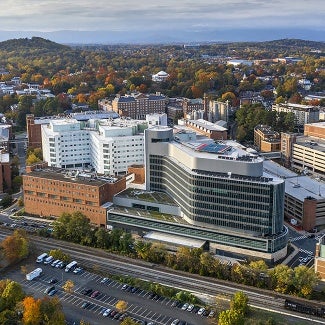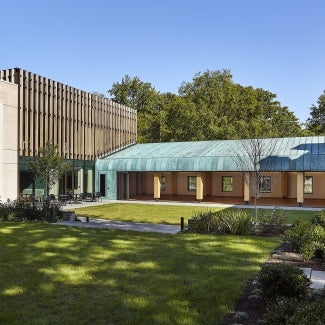Mount Auburn Cemetery - Bigelow Chapel and New Crematory
The award-winning interior architecture for the Bigelow Chapel and New Crematory at Mount Auburn Cemetery in Cambridge, Mass. reflects Mount Auburn’s forward-thinking approach to end-of-life services.

Project highlights: Mount Auburn Cemetery - Bigelow Chapel and New Crematory
- Architect: William Rawn Associates, Inc.
- Owner: Mount Auburn Cemetery
- Location: Cambridge, Mass.
Consecrated in 1831 and designated a National Historic Landmark in 2003, Mount Auburn Cemetery in Cambridge, Massachusetts, stands as one of the most important and complex landscapes in the United States. In addition to being an active cemetery, its functions as a public green space, botanical garden, and outdoor museum of funerary art. This project has transformed Bigelow Chapel, the historic first building constructed on the cemetery grounds, into a space for public programs for the first time in
decades. A carefully placed addition also supports a new crematory that serves a wide range of families and religious groups, reflective of Mount Auburn’s forward-thinking approach to end-of-life services.
Originally built in 1845 as a response to the cemetery’s growing popularity, Bigelow Chapel was repurposed as a crematory chapel in 1899 during a time when cremation was a nascent practice in conservative New England. In recent decades, disrepair and a lack of ADA access had rendered the building largely unusable, but the renovation has restored the chapel to the original vision of the cemetery’s founders as a multifunctional space with unencumbered access. To achieve that, the team lowered the raised alter that was added in the 1920s to its original position and carefully tucked lighting into the ceiling arches. The chapel’s grand rose window was painstakingly restored by a local stained glass specialist, transforming the once-dark space with colorful light.
The glass-walled addition to the chapel was informed by the Boston area’s Hindu and Buddhist communities, for whom participatory cremation is an integral part of the grieving process. Before this project, the region had no such setting to support those communities.
The addition is organized as a procession that begins with expansive views of the cemetery upon entrance and progression to the gathering room. After moving into the viewing room, where cremation commitment ceremonies are held, the space becomes much more contemplative, and views are directed toward an internal garden housed between the addition and the historic chapel. After ceremonies, large doors open onto the gathering room, and, in an affirmation of life, participants are once again greeted with panoramic views of the landscape.
Since the project was completed, the cemetery has supported a range of diverse religious groups in ways not previously possible. The number of cremation and commitment viewings has increased exponentially, and they have all been enhanced by the new facility. Bigelow Chapel now sees much more use, hosting everything from funeral services to yoga and meditation sessions. Because of the simple yet flexible design with a strong connection to the landscape, the building can easily accommodate these new uses.
Project team & Jury
Engineer: Structural – LeMessurier Consultants
Engineer: MEP/FP/Civil/AV/IT – Rist-Frost-Shumway Engineering, P.C.;
Engineer: Geotechnical – Haley & Aldrich;
Engineer: Environmental – Amec Foster Wheeler;
General Contractor – Shawmut Design and Construction;
Owner’s Project Manager – CSL Consulting;
Landscape Architect – Halvorson | Tighe & Bond Studio (as Halvorson Design Partnership);
Lighting – Horton Lees Brogden Lighting Design ;
Specifications – Kalin Associates, Inc. ;
Acoustics – Acentech;
Code Consultants – Sullivan Code Group;
ADA Consultants – Kessler McGuinness and Associates, LLC.;
Envelope Consultant – Building Envelope Technologies ;
Preservation Architects for Rose Window Restoration – McGinley Kalsow & Associates, Inc.;
Rose Window Restoration – Serpentino Stained Glass Studio
Rudabeh Pakravan, AIA, Chair, Sidell Pakravan, Berkeley, Calif
Rebecca Brady, AIA, Clark Nexsen, Virginia Beach, Va.
Joyce Selina Love, AIA, DesignLoveStudio, Memphis, Tenn.
Alejandra Menchaca, Thornton Tomasetti, Boston
Melanie Ray, AIA, Hord Coplan Macht, Inc., Baltimore
The Interior Architecture program celebrates the most innovative and spectacular interior spaces. Impactful building interiors make their mark on the cities, places, and spaces where we live and work.
Explore eight projects showcasing the best in interior architecture and design.













